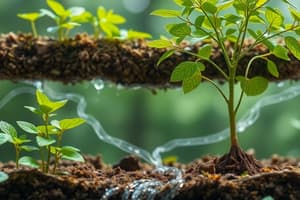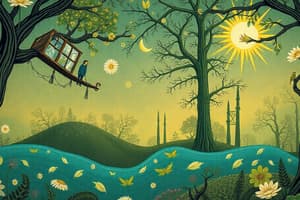Podcast
Questions and Answers
What is the primary source of energy in most ecosystems?
What is the primary source of energy in most ecosystems?
- Heterotrophs
- Decomposers
- Sunlight (correct)
- Autotrophs
Which of the following best describes an ecosystem?
Which of the following best describes an ecosystem?
- The interactions between populations of different species
- The totality of life in the biosphere
- All the living things in a specified area
- All the biotic and abiotic factors in an area (correct)
Which term describes all members of the same species in a given area?
Which term describes all members of the same species in a given area?
- Population (correct)
- Ecosystem
- Community
- Biome
What characterizes autotrophs in an ecosystem?
What characterizes autotrophs in an ecosystem?
In a food chain, what do the arrows represent?
In a food chain, what do the arrows represent?
What percentage of energy is typically passed on to the next trophic level?
What percentage of energy is typically passed on to the next trophic level?
Which of the following best defines a biome?
Which of the following best defines a biome?
What distinguishes heterotrophs from autotrophs?
What distinguishes heterotrophs from autotrophs?
Flashcards
Ecology
Ecology
The study of how living things interact with each other and their environment.
Biotic Factors
Biotic Factors
All the living things in an ecosystem.
Abiotic Factors
Abiotic Factors
All the non-living things in an ecosystem.
Autotroph
Autotroph
Signup and view all the flashcards
Heterotroph
Heterotroph
Signup and view all the flashcards
Food Chain
Food Chain
Signup and view all the flashcards
Energy Transfer
Energy Transfer
Signup and view all the flashcards
Trophic Levels
Trophic Levels
Signup and view all the flashcards
Study Notes
Unit 1 - Energy and Matter Flow
- Energy in most ecosystems originates from the sun.
- Abiotic factors are non-living elements (e.g. air, water, rocks).
- Biotic factors are living elements (e.g. plants, animals, fungi).
- Organism: single living thing
- Population: all organisms of one species in a specific area
- Community: all living things in an ecosystem
- Ecosystem: biotic and abiotic factors in an area
- Biome: all members of the same species in an area
- Biosphere: all parts of Earth capable of supporting life
- Autotrophs produce their own food from sunlight (e.g., plants).
- Heterotrophs obtain energy by consuming other organisms (e.g., animals).
- Food chains display energy flow; arrows show the direction.
- Food webs depict the complex interrelationships in an ecosystem.
- Only 10% of energy transfers between trophic levels.
Levels of Ecology
- Organism: a single, individual living thing.
- Population: a group of the same species living in the same area.
- Community: all populations in an area that interact with each other.
- Ecosystem: all biotic (living) and abiotic (non-living) factors in a given area.
- Biome: a large geographic area characterized by similar climate and dominant plant life.
- Biosphere: The sum of all ecosystems on Earth.
Differences between Autotrophs and Heterotrophs
- Autotrophs (producers) make their own food (e.g. plants).
- Heterotrophs (consumers) obtain energy by consuming other organisms.
Food Chains and Food Webs
- Food chains show the linear flow of energy from one organism to another.
- Food webs show the complex network of interactions among organisms in an ecosystem.
- Arrows in a food chain indicate the direction of energy transfer.
Energy Transfer
- Energy flows through an ecosystem in one direction.
- Only a portion (10%) of energy is transferred from one trophic level to the next.
- The remaining energy is released into the atmosphere as heat.
Unit 2 - Biomes and Adaptations
- Biomes are large geographic areas with similar climates and plant life.
- Different biomes support various animal and plant species.
Unit 3: Biodiversity
- Symbiosis is a close relationship between two or more different species.
- Mutualism: (+/+) both benefit.
- Commensalism: (+/0) one benefits, the other is unaffected.
- Parasitism: (+/-) one benefits, the other is harmed.
- Invasive species can disrupt ecosystems, often negatively impacting biodiversity.
Unit 4 - Populations
- Population density is the number of individuals per unit area.
- Limiting factors affect population growth (e.g., food, water, predators).
- Exponential growth occurs when a population increases rapidly.
- Logistic growth occurs when a population's growth slows as it reaches carrying capacity.
- Carrying capacity is the maximum population size an environment can sustain.
- Density-dependent factors affect a population based on its density (e.g., competition, disease).
- Density-independent factors affect a population regardless of its density (e.g., natural disasters).
Studying That Suits You
Use AI to generate personalized quizzes and flashcards to suit your learning preferences.




